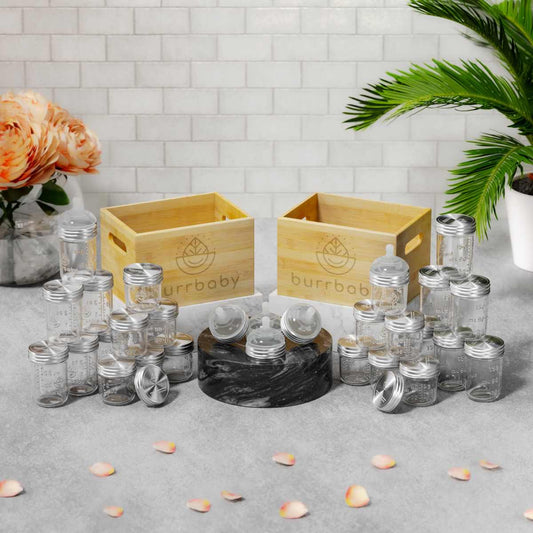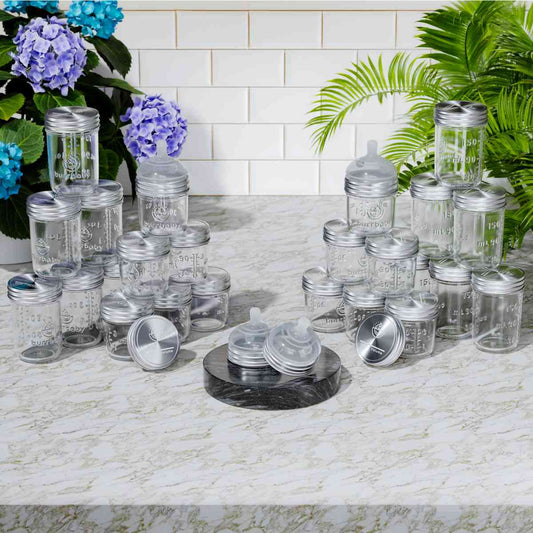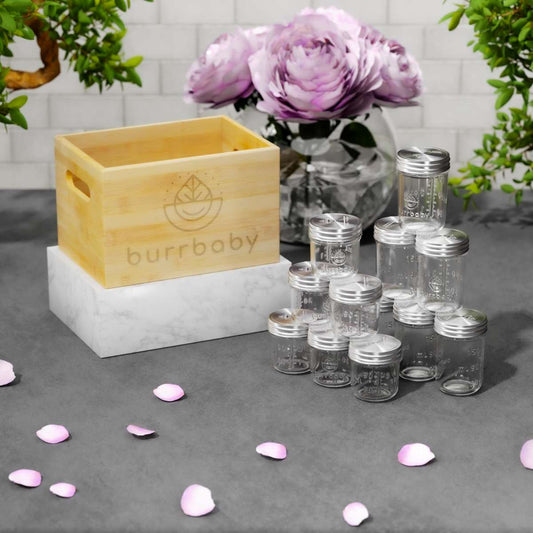Embarking on your parenting journey means you're about to be involved in a ton of new decisions. Within our busy lives as parents, the environmental impact of our choices may sometimes be overlooked. However, making eco-friendly and sustainable choices as a parent might be easier than you think.
In this article, we'll explore practical ways to embrace greener choices in various aspects of parenting, from feeding to diapering and beyond. We'll also discuss how the products and brands we choose, like Burrbaby's eco-friendly glass breastmilk storage and glass bottles, contribute to a sustainable parenting experience.
Let's cultivate a greener, healthier lifestyle for our families.
Article Overview
- Sustainable feeding practices for your baby.
- Sustainable diapering options.
- Eco-friendly baby products.
- Green household habits.
- Educating your children about sustainability.
At Burrbaby, we're dedicated to being a part of a healthier world for your children. We hope to accomplish this through our zero-plastic glass breast milk storage containers and bottles. These completely non-toxic, sustainable choices protect your baby's health and our planet.
Sustainable Feeding Practices for Your Baby
In almost every area of raising children, we can make green choices. Feeding is no exception.
The Power of Breastfeeding
Breastfeeding is widely regarded as one of the most eco-conscious feeding choices you can make. According to the World Health Organization, breastfeeding provides optimal infant nutrition while reducing the ecological footprint linked to the production and disposal of formula packaging.
With numerous health benefits for both you and your baby, breastfeeding is a fantastic way to nourish your baby and minimize waste.

Eco-Friendly Feeding Products
When storing and feeding your breast milk or formula, selecting sustainable products can make a world of difference.
For instance, you can use glass containers to safely store breast milk in the fridge and freezer, and reuse the them indefinitely. This eliminates hundreds to thousands of disposable plastic breast milk storage bags.
When paired with reusable food-grade stainless steel lids and silicone nipples, these glass storage containers can easily transform into feeding bottles. Not only is this convenient, but it further eliminates the need for plastic bottles.
To discover more about using glass containers to store breast milk, head here.
The Pitcher Method for Milk Storage
Another green feeding practice worth exploring is the pitcher method of breast milk storage. This technique combines milk from several pumping sessions during the day into a single container, streamlining the process and reducing overall storage needs. Choose eco-friendly materials such as glass pitchers with wooden lids to minimize your environmental impact while keeping breast milk fresh and ready for feeding.
By incorporating these green feeding practices into your parenting routine, you can positively contribute to your baby's health and the well-being of our planet.
Sustainable Diapering Options
Unfortunately, studies show disposable diapers generate substantial waste, making them a major environmental concern. Fortunately, several eco-friendly diapering options can help parents adopt sustainable practices without compromising their child's comfort and cleanliness.
Cloth Diapers
Cloth diapers have been around forever and provide an environmentally friendly alternative to traditional disposables. They can be rafted from natural, reusable materials like cotton, bamboo, or hemp, cloth diapers can reduce waste while still being functional.
With a plethora of styles, patterns, and fastening options available, parents can select the cloth diaper system that works best for their family. Moreover, cloth diapers are cost-effective, saving families hundreds of dollars throughout their baby's diapering journey.
Compostable and Biodegradable Disposable Diapers
If you find cloth diapers impractical, compostable and biodegradable disposables are another sustainable choice. These diapers break down more rapidly than their conventional counterparts, decreasing their environmental impact.
Compostable diapers are manufactured from renewable resources like corn, wheat, and wood pulp, and emit fewer greenhouse gases and utilize fewer non-renewable resources during production. Some brands even offer certified compostable diapers that can be safely composted at home or in designated facilities.
Reducing Diaper Waste
Parents can adopt additional strategies to minimize waste regardless of the chosen diapering method. For instance, using cloth wipes instead of disposable ones can have a considerably less environmental impact. By combining sustainable diapering practices with waste-reducing measures, families can foster a greener, healthier environment for their children to thrive in.
Eco-friendly Baby Products
Embracing a green lifestyle encompasses more than just nutrition and diapering. Thankfully, many environmentally friendly baby products are available to support your eco-friendly parenting journey.
Choosing natural and organic baby care items
When it comes to baby care products, selecting natural and organic options can minimize exposure to harmful chemicals. Many conventional baby products contain ingredients that may cause irritation and also that we don't know the long-term effects of.
By choosing products made from organic or other natural ingredients, you're investing in your child's well-being and protecting the environment simultaneously.
Sustainable baby clothing and toys
Clothing and toys are also essential consider the environmental impact of. The fashion industry is known for its environmental impact; as such, eco-conscious parents can seek out sustainable and ethically produced baby clothing made from materials like organic cotton, bamboo, and wool.
These fabrics are gentle on your baby's skin and have a smaller carbon footprint than synthetic alternatives. Better yet, buying use clothing and toys is just about the best thing you can do.
Similarly, choosing eco-friendly toys made from sustainable materials, like wood contributes to a greener playtime. The Green Parent Magazine highlights the importance of selecting toys free from harmful chemicals and made from responsibly sourced materials.
To read more benefits of non-plastic toys, head here.

Importance of avoiding harmful chemicals in baby products
As mentioned earlier, harmful chemicals are prevalent in many baby products, posing potential health risks. You can safeguard your child's well-being and the environment by choosing care products with simple, natural ingredients.
One excellent example of eco-friendly products are Burrbaby's glass containers for breast milk storage and bamboo organization box. We created them for families like yours who are trying to eliminate the risks associated with plastics and provide a sustainable alternative to traditional baby bottles.
Greener Household Habits
Embracing eco-friendly habits in your household supports a healthier environment and fosters an atmosphere of responsibility and mindfulness for the whole family. We can reduce our ecological footprint and contribute to a greener planet by making simple yet effective changes in our day-to-day routines.
Energy conservation tips for families
Reducing energy consumption is one of the most impactful ways to create a sustainable home. Swapping traditional incandescent bulbs for energy-efficient LED lighting is a small change that can make a significant difference.
Encourage family members to turn off lights and unplug electronics when not in use, as these seemingly minor habits can lead to substantial energy savings over time. Additionally, consider investing in energy-efficient appliances and smart home technology to decrease your household's energy consumption further.
Reducing water consumption
Water is a precious resource, and conserving it should be a priority in every eco-conscious household. Encourage your family to adopt simple water-saving practices like turning off the tap while brushing your teeth or taking shorter showers.
Installing low-flow faucets and showerheads can significantly reduce water use without compromising comfort. Moreover, being mindful of the amount of water you use for cleaning, cooking, and gardening can further contribute to a greener home.
Recycling and composting family waste
Proper waste management is essential to minimizing our impact on the environment. By recycling paper, glass, metal, and plastic, we can conserve resources and reduce pollution. Create a designated recycling area in your home to make the process more convenient and accessible for all family members.
Composting food scraps and yard waste is an excellent way to produce nutrient-rich soil for your garden while keeping these materials out of landfills. In addition, by embracing these greener household habits, you can set a positive example for your children and contribute to a healthier, more sustainable future.
And it's a fun hobby to get into as well!
Educating Your Children About Sustainability
Fostering a love for the environment in your little ones lays the groundwork for a brighter, greener future. By teaching your children about sustainability, you empower them to make responsible choices that benefit their well-being and our planet.

Introduce Eco-Friendly Habits Early On
One of the most impactful ways to instill environmental responsibility in your children is by introducing eco-friendly habits early on. The National Wildlife Federation (NWF) suggests incorporating hands-on activities to engage your child in understanding the interconnectedness of our natural world.
For instance, gardening together can spark conversations about plants, animals, and ecosystems while fostering a sense of stewardship for the environment.
Involve Children in Eco-Friendly Tasks at Home
Alongside outdoor activities, you can also involve your children in eco-friendly tasks at home. For example, assigning age-appropriate responsibilities like sorting recyclables or turning off lights not in use teaches them about resource conservation and the importance of reducing waste.
Using everyday moments as learning opportunities can help reinforce these sustainable practices, turning them into lifelong habits.
Engage Children in Creative Eco-Friendly Crafts and Activities
Introducing creative and fun eco-friendly crafts and activities will keep your children engaged while learning about sustainability. DIY projects such as creating art from recycled materials or upcycling old clothes can inspire innovation and resourcefulness in your little ones. In addition, these hands-on experiences encourage them to think critically about their consumption patterns and appreciate the value of repurposing.
Encourage Participation in Community Environmental Projects
Lastly, encouraging your children to participate in community environmental projects, such as park clean-ups or tree-planting events, fosters a sense of social responsibility and connectedness with the natural world around them. This involvement strengthens their connection to the environment and helps them understand their actions' impact on the world around them.
Building a Healthier, More Sustainable World for Our Children
As parents, our lives are busy. The path to sustainable parenting doesn't mean you have to uproot your entire lifestyle on day one. Just make small, mindful choices along the way, and try to teach your children to do the same.
You can substantially reduce your environmental footprint by making mindful choices in feeding, diapering, product selection, and household habits. For example, incorporating glass milk storage and bottle containers, like those offered by Burrbaby, is just one example of how minor adjustments can contribute to a more sustainable lifestyle.
References:
McEachan, R. R. C., Yang, T. C., Roberts, H., Pickett, K. E., Arseneau-Powell, D., Gidlow, C. J., ... & Nieuwenhuijsen, M. (2016). Availability, use of, and satisfaction with green space, and children's mental well-being at age 4 years in a multicultural, deprived, urban area: results from the Born in Bradford cohort study. The Lancet Planetary Health, 3(6), e244-e254 https://www.thelancet.com/journals/lanplh/article/PIIS2542-5196(18)30119-0/fulltext
Sathyanarayana S, Alcedo G, Saelens BE, Zhou C, Dills RL, Yu J, Lanphear B. Unexpected results in a randomized dietary trial to reduce phthalate and bisphenol A exposures. J Expo Sci Environ Epidemiol. 2013 Jul. https://pubmed.ncbi.nlm.nih.gov/23443238/
Real Diaper Association. https://realdiaperassociation.org/
Geyer, R., Jambeck, J. R., & Law, K. L. (2017). Production, use, and fate of all plastics ever made. Science Advances, 3(7), e1700782. https://www.science.org/doi/10.1126/sciadv.1700782
Andrady, A. L. (2011). Microplastics in the marine environment. Marine Pollution Bulletin, 62(8), 1596-1605. https://pubmed.ncbi.nlm.nih.gov/21742351/
World Health Organization. https://www.who.int/health-topics/breastfeeding#tab=tab_1
Meeker, J. D., Sathyanarayana, S., & Swan, S. H. (2009). Phthalates and other additives in plastics: human exposure and associated health outcomes. Philosophical Transactions of the Royal Society B: Biological Sciences, 364(1526), 2097-2113. https://www.ncbi.nlm.nih.gov/pmc/articles/PMC2873014/
Burdette, H. L., & Whitaker, R. C. (2005). Resurrecting Free Play in Young Children: Looking Beyond Fitness and Fatness to Attention, Affiliation, and Affect. Archives of Pediatrics & Adolescent Medicine, 159(1), 46–50. https://jamanetwork.com/journals/jamapediatrics/fullarticle/485902
Henkel C, Hüffer T, Hofmann T. Polyvinyl Chloride Microplastics Leach Phthalates into the Aquatic Environment over Decades. Environ Sci Technol. 2022 Oct 18;56(20):14507-14516. doi: 10.1021/acs.est.2c05108. https://pubmed.ncbi.nlm.nih.gov/36154015/
American Academy of Pediatrics https://www.aap.org/
La Leche League International https://llli.org/
Chawla, L. (2007). Childhood experiences associated with care for the natural world: A theoretical framework for empirical results. Children, Youth and Environments, 17(4), 144-170. https://www.researchgate.net/publication/284662165_Childhood_experiences_associated_with_care_for_the_natural_world_A_theoretical_framework_for_empirical_results
Green Parenting ParentMap.
National Wildlife Federation https://www.nwf.org/
Energy Star https://www.energystar.gov/
Environmental Protection Agency https://www.epa.gov/
Goleman, D. (2009). Ecological Intelligence: How Knowing the Hidden Impacts of What We Buy Can Change Everything. Broadway Business
Green Parent Magazine https://thegreenparent.co.uk/










